Lower temperatures and moist soils may favor the quality of the next coffee harvest
By Williams Ferreira and Marcelo Ribeiro, researcher at Embrapa Café/EPAMIG Sudeste in the area of Agrometeorology and Climatology
With reduced dimensions, the U60 tested by Cultivar Máquinas in the production of flowers in a greenhouse showed that its turning radius, traction capacity and fuel economy are attributes that make this model stand out in activities in reduced spaces that require versatility.
Restarting our tests for Revista Cultivar Máquinas, at the beginning of 2022 we moved to the city of Jacutinga, in the state of Minas Gerais. There we went to learn about the integration of the LS tractor, model U60, in flower production. This tractor model is one of the brand's best-selling models for small properties. We have already tested it on three other occasions and in very different situations. The platform version could be observed in Venâncio Aires and São Pedro do Sul, municipalities located in the state of Rio Grande do Sul, and the cabin version in Carambeí, Paraná, all with one thing in common: customer satisfaction. The LS U60 is a small tractor, with a great turning radius, as well as a powerful and economical engine. In fact, the common point found in the tests already carried out.
To learn about the LS U60's work in floriculture, we went to the company Rosas Jacutinga, part of Grupo Esperança. The business group has five units distributed between the states of Minas Gerais and São Paulo. In addition to the Jacutinga (MG) unit, which is a branch, it has two units, Vale das Flores I and II, in Andradas (MG), and two others in Holambra (SP), Rosas Esperança and Laguna Orquídeas. Grupo Esperança, owned by businessman Miguel Renato Esperança, is known nationally for its quality production and has been operating in the field for approximately 35 years, with the Jacutinga unit being the youngest in operation, at 14 years old. The main flowers produced by the group are roses, orchids and alstromeria.
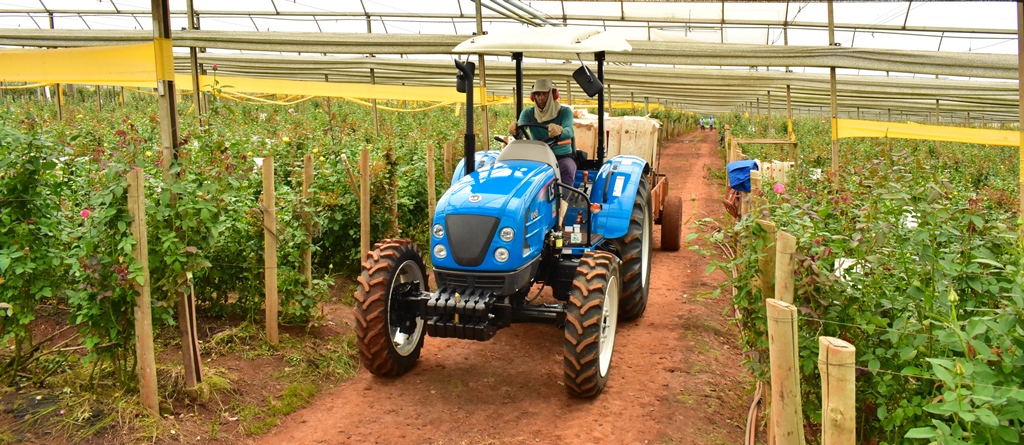
Roses, at the Jacutinga unit, are produced in greenhouses that form approximately 6,7 hectares of covered area. In this unit, the LS model U60 tractor is the second of the brand acquired by the group. During the visit, we were received by agronomist Diego Henrique da Silva, administrator of the unit, who showed us and provided all the information about the activity and, mainly, about the potential for mechanization and use of tractors in the floriculture sector. With his ten years of work experience in the Group, and in the unit, he told us a little about the history and difficulties over the years, especially in the last two, when dealing with the pandemic. He explained to us that the entire floriculture sector suffered from the effects of the Covid-19 outbreak, mainly due to the cancellation of social and family events. There was a need to discard a large part of the production, as the product is fragile and perishable.
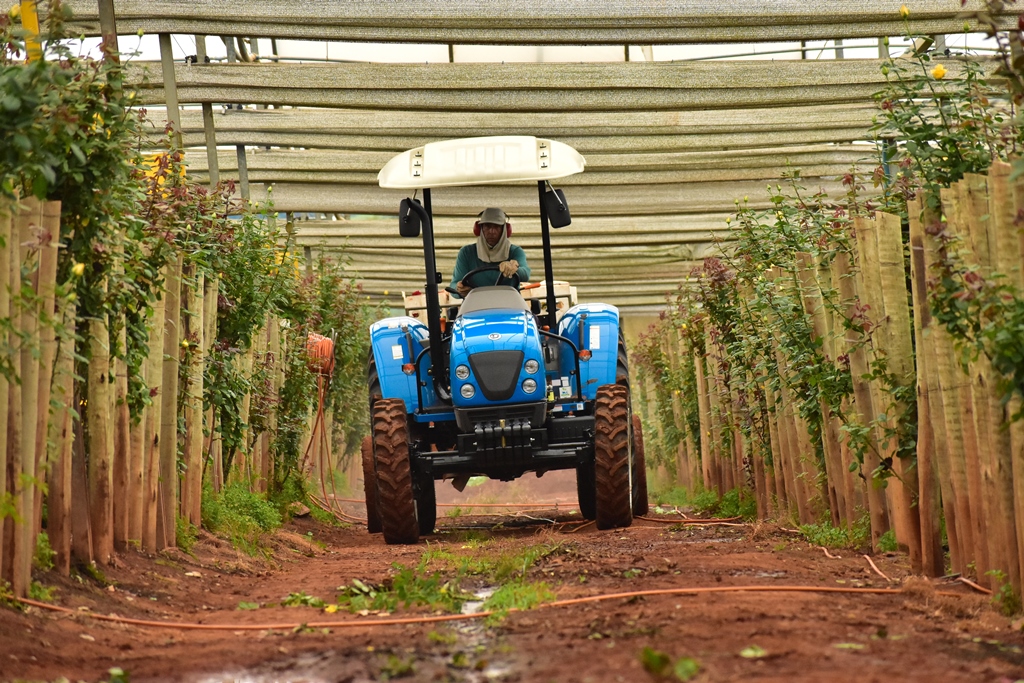
However, at the end of 2021 there was a resumption of activities in which flowers are used and the market began to heat up again. Thus, after a terrible year in 2020 for the sector, in 2021 floriculture reinvented itself and in 2022 growth is expected to resume. As in all crises, the search for solutions leaves positive experiences, and in the case of the floriculture sector, the increase in sales through delivery was one of them.
The flower market is traditionally supported by regular consumption throughout the year, but with a marked seasonality. After a small drop in consumption during the end of the year, demand peaks occur on three specific dates, in order: International Women's Day, celebrated on March 8, Mother's Day, on the second Sunday of May , this year it will be on May 8th, and Valentine's Day, which is celebrated on June 12th. Therefore, these dates correspond to peak demand for roses and other flowers.
The production is sold entirely through the cooperative system, in this case Cooperflora, which receives all the material from Grupo Esperança units and sells it to customers, the majority of whom are loyal. The destination of most of the production is the South of the country, although there are customers throughout Brazil. Due to the fragility of the product after harvest, the material remains in a cold room for a maximum of 15 days, in the shed, and is then sent to the customer. Currently, the unit employs approximately 75 people, the majority of whom are women, including 30 cutters who work 8,5 hours a day, half an hour of overtime. Since the unit is a little far from the city center, two buses bring and take workers daily.
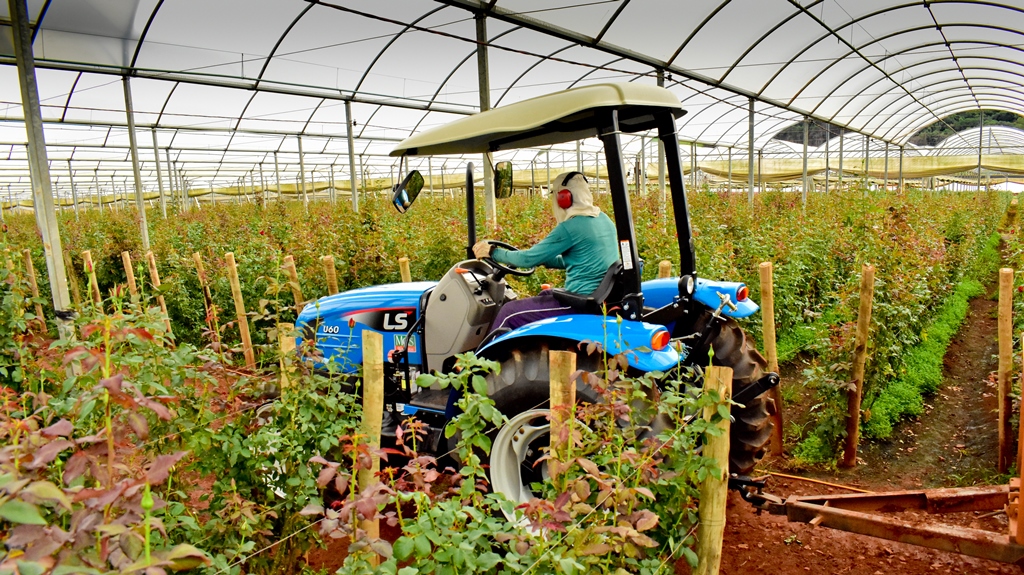
The acquisition of the LS U60 tractor, for Grupo Esperança's Jacutinga unit, came from the need to expand the mechanization of operations carried out during the rose bush growth cycle, to carry out the preparation of new beds and the operations required by beds undergoing renovation, in addition to qualifying the transport of material within the unit. The entire process of choosing and purchasing the tractor was based on recommendations from the Andradas unit, which already has a tractor from the brand. By the way, the acquisition of equipment by the Group is carried out based on various research and consultations, in addition to considering the opinion of all unit managers.
Currently, at the Jacutinga unit, the application of chemical products to protect plants is done using a system of hoses and pumping through a central pump. An operator drives a small bar across the top of the plants, one row at a time. Even though all the necessary personal protective equipment is offered, in the future it is intended to use the LS U60 tractor coupled to a turbo atomizer or a spray cannon, moving along the existing streets inside the greenhouses, mechanizing the operation.
At the Vale das Flores I and II units, in Andradas (MG), mechanization is greater, occupying the first LS brand tractor that was acquired by the Group. The evaluation of the R60 cabin made by Anderson Esperança, son of the owner and in charge of the Andradas units, is very positive. After its purchase at Hortitec in 2019, this tractor became responsible for preparing the soil of the new beds and spraying plant protection products with a spray cannon. According to him, the power provided by the tractor is very satisfactory for its size, carrying out operations economically and providing comfort to the operator.
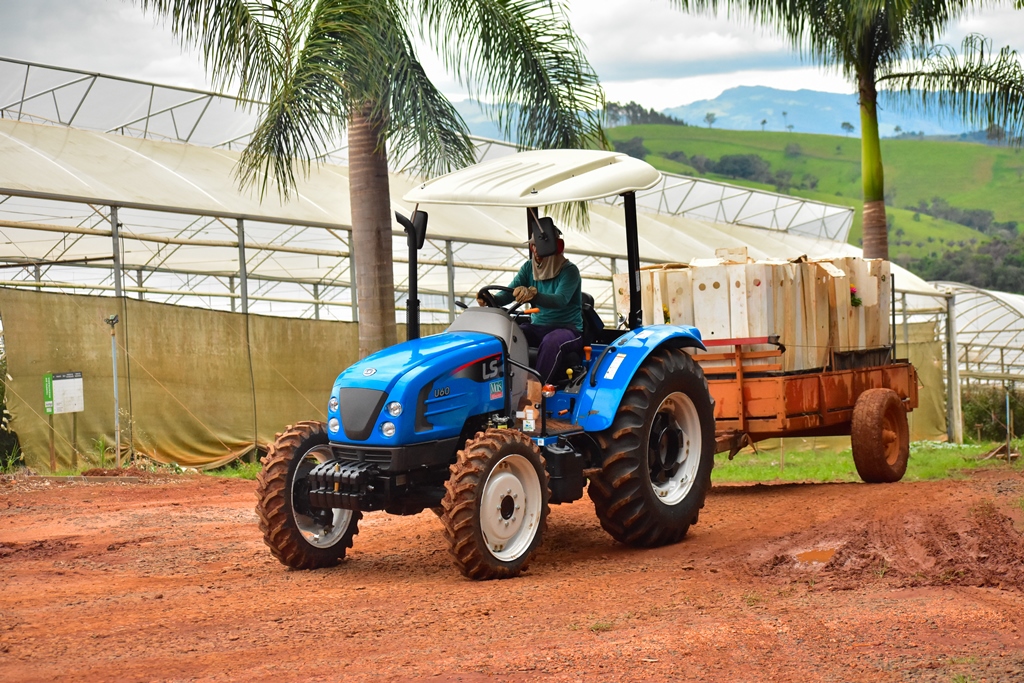
Also, the group's immediate plans are to use the LS U60 to renew part of the production that takes place by eliminating plants from the bed and through some soil preparation operations. During our visit we saw the beginning of the removal of the seedlings that will be replaced. After this stage, the remains of the rose bushes are removed and then a scarifier is used, followed by harrowing. After preparing the soil, a tiller is used, forming the layer for placing the new plants.
During the survey of the needs for the mechanization of the Jacutinga unit, the predefined requirements for choosing the tractor were based on: being small enough to move between streets within the facilities, having a reduced turning radius for maneuvers (in a small space ), traction capacity, equipped with auxiliary front-wheel drive and sufficient engine power for the heavy work of preparing the soil, when renovating construction sites. Therefore, according to the expectations of the person responsible for the unit, all requirements were met in the LS Tractor U60 model.
The LS U60 uses an LS brand engine, model L4AL-T1 – Tier 3, 65 hp, according to ISO TR 14396, at a speed of 2.600 rpm. Maximum torque is 203Nm obtained at 1.600rpm. It is a four-cylinder engine, with 2.621cm³, 16 valves and turbocharged aspiration. The injection pump is a rotary type from the LS brand and the fuel is Diesel.
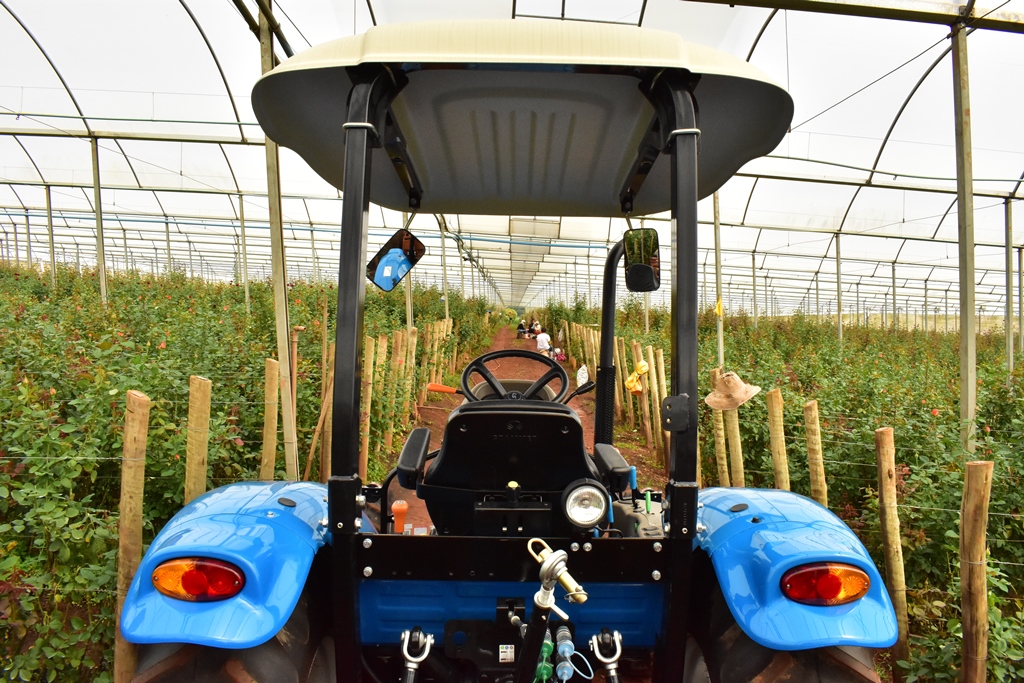
The power transmission is of the Synchro Shuttle type with 32 forward and 16 reverse speeds, with a Creeper super-reducer, which provides very low working speeds. The choice of gears is done using two levers, one for the speeds (four gears) and one for the groups (four groups), positioned one on each side of the operator's seat, in addition to the super-reducer lever. This model stands out, within its category, for having as standard a synchronized mechanical reverser, which allows the same number of forward and reverse gears, simply by changing the position of the lever.
As this tractor is of the TDA type (auxiliary front-wheel drive), the front axle is driven, from the LS brand, and has a particularity that is the use of conical gears instead of crossheads, which, in addition to providing greater resistance, reduces the radius tractor turning.
The power take-off (TDP) is independent and has an electric-hydraulic activation via a switch located on the instrument panel. Unlike most small tractors, which only have a standard speed of 540 rpm, the U60 has three speed options (540/750/1.000 rpm). The standard speed of 540rpm is used in most agricultural operations. The 1.000rpm speed is only used in special equipment and the 750rpm speed is used as an economical PTO, as the usual 540rpm is reached at a lower engine speed, which allows fuel savings in operations that require less power.
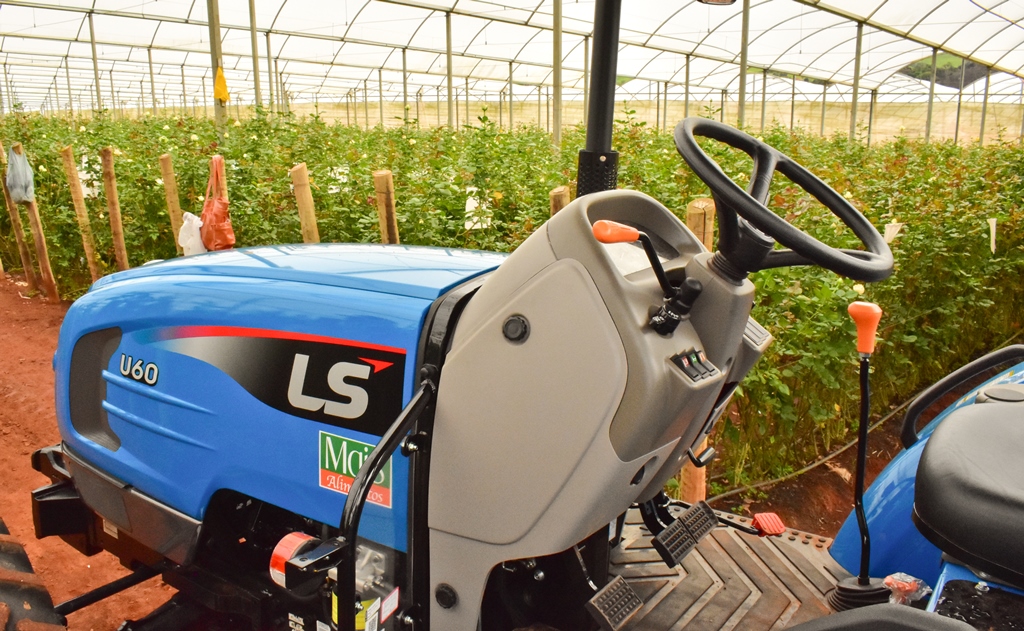
The hydraulic system consists of two pumps, one for the three-point lifting system (category II) and the remote control valves and another exclusive for the steering system. The total flow rate of the hydraulic system is 72 liters per minute and the maximum pressure is 167bar. The three-point lifting system has a maximum capacity of 2.200kgf at the ball joint. The tractor has a remote control with two double-acting valves and quick coupling. As an optional item, this model can have up to three valves. There are two levers to control the hydraulic system, one for depth control and the other for lowering and raising the implement. Furthermore, it has an automatic system (liftmatic) in which it is possible to adjust the lifting height. By pressing a small lever, the system lifts the implement, lowering it using a button switch to the pre-selected depth. There is also a valve to control the implement's descent speed, located below the operator's seat, which allows the descent speed to be increased or decreased, depending on the sensitivity of the implement and the soil conditions.
The tractor's shipping weight is 2.395kg and the maximum that can be achieved with ballast is 3.380kg. The tractor has a maximum front track of 1.840mm and a maximum rear track of 1.740mm. The wheelbase is 2.047mm and the overall length is 3.778mm. The maximum height of the tractor when equipped with Rops is 2.614mm. Furthermore, the hood opening stands out in this model, which tilts backwards, offering space for tractor maintenance work.
LS Tractor arrived in Brazil 9 years ago and is currently one of the most important suppliers of small and medium-sized tractors in the country. One of the brand's reference models is the U60 model, tested by Cultivar Máquinas. The factory is located in the municipality of Garuva, Northeast region of the state of Santa Catarina, close to Joinville (SC) and Curitiba (PR). This unit produces models ranging from 40hp to 145hp. All series produced in Brazil have a Finame Code and can be financed by government programs to encourage mechanization, such as Finame, ModerFrota or Mais Alimentos.
The LS brand dealership network grows every year. In the city of Jacutinga (MG), where we carried out this test for Revista Cultivar, the dealer is JA Máquinas, a branch in Mogi Mirim (SP). The JA Máquinas headquarters store is located in Jaú (SP).
We were with us during the visit and field evaluation of the tractor, Mr. Sidinei Lorencetti, who is a sales consultant at the dealership JA Máquinas, in Mogi Mirim, and the store manager, Ademir Chiquetti Júnior, the great enthusiast of LS Tractor's participation in the Guardian tractor in the Trekker Trek Competition, which brings together tractors to compete for traction capacity. Representing the manufacturer was Mr. Rodrigo Barbará Silva, commercial coordinator of LS Tractor for the state of São Paulo.
In the region, where fruit and flower producing customers predominate, the best-selling models are the Plus 80 and U60, often coupled with long-range spraying equipment, 600-liter tanks. According to Mr Sidinei, some of the biggest compliments to these models are the engine power for the size of the tractor, the fuel economy and the presence of the super-reducer.

Receive the latest agriculture news by email